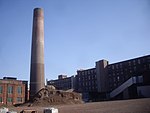Harrison station (NJ Transit)
1906 establishments in New JerseyDemolished railway stations in the United StatesFormer Delaware, Lackawanna and Western Railroad stationsFormer NJ Transit stationsFormer railway stations in New Jersey ... and 5 more
Harrison, New JerseyNew Jersey railway station stubsPages with no open date in Infobox stationRailway stations closed in 1984Railway stations in the United States opened in 1906

Harrison was a station on New Jersey Transit's Morris & Essex Lines (consisting of the Montclair Branch, Morristown Line and Gladstone Branch) in Harrison, New Jersey, United States. The station was built by the Delaware, Lackawanna and Western Railroad in 1906. It was situated between Newark Broad Street Station and Hoboken Terminal. The station remained in service during most of the 20th century, until New Jersey Transit closed the station on September 16, 1984 with Roseville Avenue in Newark. The station was demolished shortly afterwards.
Excerpt from the Wikipedia article Harrison station (NJ Transit) (License: CC BY-SA 3.0, Authors, Images).Harrison station (NJ Transit)
South 2nd Street,
Geographical coordinates (GPS) Address Nearby Places Show on map
Geographical coordinates (GPS)
| Latitude | Longitude |
|---|---|
| N 40.745055555556 ° | E -74.160555555556 ° |
Address
South 2nd Street 101
07029
New Jersey, United States
Open on Google Maps







